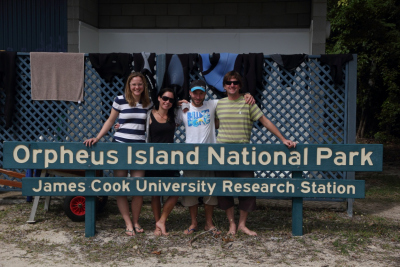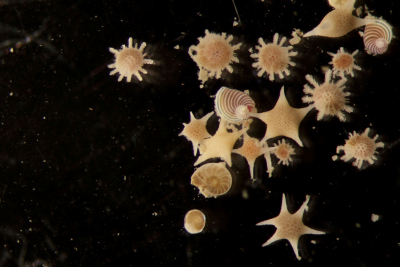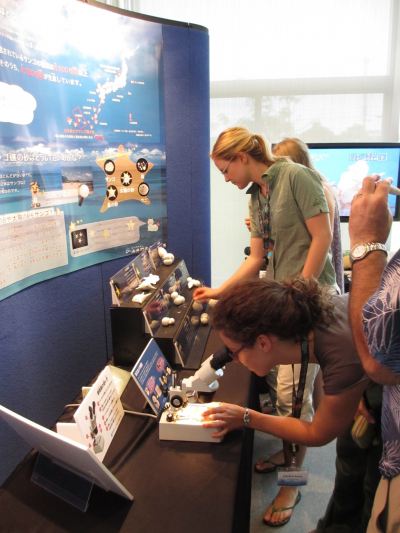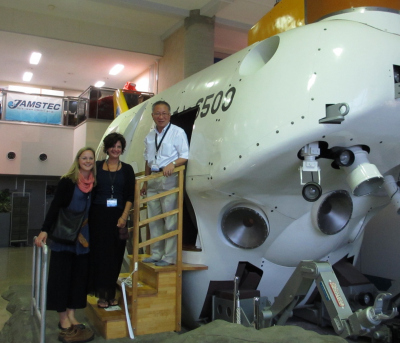Page path:
- Graduate School GLOMAR
- PhD student reports
- Other activities
- Christiane Schmidt
Christiane Schmidt
Report of GLOMAR PhD student Christiane Schmidt about her participation in the International Coral Reef Symposium 2012, Cairns, Australia, 9 - 13 July 2012 and an expert workshop on the Culturing of Living Foraminifera in Yokosuka and Okinawa, Japan 15 - 21 July 2012 as well as a two-week stay at the Australian Institute of Marine Science, Townsville 22 June - 9 July
In July 2012 a unique opportunity occurred to combine the participation at a leading international conference in Australia with an expert training workshop in Japan and a research stay at AIMS in Australia. Since all three events are directly relevant to my PhD thesis work, a contribution towards the travel costs has been provided through GLOMAR. Further support was secured by obtaining a fee waiver student award for the ICRS conference and also by obtaining a student grant from the organizers of the workshop in Japan. The main achievements resulting from my participation in the three events are outlined below.
The largest international coral reef conference is held every four years by the International Society for Coral Reef Studies (ISRS). This huge event with more than 2500 participants from over 80 countries was hosted at a venue in Cairns, Australia from 9 -13 July this year. The conference audience was very broad, ranging from natural scientists, resource managers, conservationists, economists, educators to graduate students, such as myself. I have contributed a talk entitled Temperature and nutrient stress on benthic Foraminifera from the Great Barrier Reef in a session on tropical Foraminifera. The community working on Foraminifera is quite small; this helped to get in contact with each other during such a big conference. I have meet Prof. Pamella Hallock an expert in the field of benthic Foraminifera from Florida. Also I enjoyed valuable scientific discussion, with fellow PhD students and researches working on living Foraminifera in Australia with whom I could reconnect. Besides the direct relevance for my PhD project I gained a broader knowledge on new methods applied on coral calcification and temperature stress and met researches working on similar research questions using different model organisms. The really unique feature of the conference was that one could also listen to talks from resource managers and social scientists working on Marine Protected Areas and other conservation topics.
This conference was followed by an expert workshop on living benthic Foraminifera in Japan from the 15-21 July. This workshop consisted of two venues in the central Island of Yokosuka, as well as the tropical island Okinawa, one and a half hours of flight time south of the main Island. This workshop has drawn over 30 experts and graduate students working on living Foraminifera together for the first time to exchange about culturing and experimental work on these unicellular organisms. Lab tours where organized at marine Station on Sesoko Island in Okinawa as well as in the laboratory of JAMSTEC Institute in Yokosuka. This workshop had a practical part of field collections from the beach and boat, as well as laboratory sessions observing the organism’s biology through microscopes. The practical part was alternated with expert lectures and student presentations on ocean acidification, host-symbiont interactions, and environmental responses. I have contributed a talk entitled Effect of global change stress on symbiont-bearing benthic Foraminifera from the Great Barrier Reef. The unique part of the workshop was that Foraminiferologists working on living planktonic and benthic species have been able to exchange knowledge on the biology of these unicellular calcifies. I got new impulses for my project from seeing the different culturing facilities used in Japan. I learned about methods finding new genetic markers in Foraminifera as well as learned about trace element incorporation during calcification, this is directly relevant for my project. Last but not least I could meet one of my committee members Dr. Sigal Abramovich who was also participating at the workshop.
The participation in these two meetings was preceded by a two-week research Stay at Australian Institute of Marine Science in Townsville from 22 June- 9 July. This stay has built on two previous projects that I conducted at the Water Quality Team at Aims in earlier years. During the stay, I was able to help with field collections at Orpheus Island National Park on benthic Foraminifera as well as their associated substrate - calcareous algae. Besides new experience in field studies, I have worked on the improvement of a protocol on quantifying the symbiont numbers in benthic Foraminifera. This methodology is directly relevant for experiments that will be carried out during my PhD work. Further, the research stay helped me to foster an important and successful collaboration with Dr. Uthicke, one of my committee members and to work on a joint publication.
The largest international coral reef conference is held every four years by the International Society for Coral Reef Studies (ISRS). This huge event with more than 2500 participants from over 80 countries was hosted at a venue in Cairns, Australia from 9 -13 July this year. The conference audience was very broad, ranging from natural scientists, resource managers, conservationists, economists, educators to graduate students, such as myself. I have contributed a talk entitled Temperature and nutrient stress on benthic Foraminifera from the Great Barrier Reef in a session on tropical Foraminifera. The community working on Foraminifera is quite small; this helped to get in contact with each other during such a big conference. I have meet Prof. Pamella Hallock an expert in the field of benthic Foraminifera from Florida. Also I enjoyed valuable scientific discussion, with fellow PhD students and researches working on living Foraminifera in Australia with whom I could reconnect. Besides the direct relevance for my PhD project I gained a broader knowledge on new methods applied on coral calcification and temperature stress and met researches working on similar research questions using different model organisms. The really unique feature of the conference was that one could also listen to talks from resource managers and social scientists working on Marine Protected Areas and other conservation topics.
This conference was followed by an expert workshop on living benthic Foraminifera in Japan from the 15-21 July. This workshop consisted of two venues in the central Island of Yokosuka, as well as the tropical island Okinawa, one and a half hours of flight time south of the main Island. This workshop has drawn over 30 experts and graduate students working on living Foraminifera together for the first time to exchange about culturing and experimental work on these unicellular organisms. Lab tours where organized at marine Station on Sesoko Island in Okinawa as well as in the laboratory of JAMSTEC Institute in Yokosuka. This workshop had a practical part of field collections from the beach and boat, as well as laboratory sessions observing the organism’s biology through microscopes. The practical part was alternated with expert lectures and student presentations on ocean acidification, host-symbiont interactions, and environmental responses. I have contributed a talk entitled Effect of global change stress on symbiont-bearing benthic Foraminifera from the Great Barrier Reef. The unique part of the workshop was that Foraminiferologists working on living planktonic and benthic species have been able to exchange knowledge on the biology of these unicellular calcifies. I got new impulses for my project from seeing the different culturing facilities used in Japan. I learned about methods finding new genetic markers in Foraminifera as well as learned about trace element incorporation during calcification, this is directly relevant for my project. Last but not least I could meet one of my committee members Dr. Sigal Abramovich who was also participating at the workshop.
The participation in these two meetings was preceded by a two-week research Stay at Australian Institute of Marine Science in Townsville from 22 June- 9 July. This stay has built on two previous projects that I conducted at the Water Quality Team at Aims in earlier years. During the stay, I was able to help with field collections at Orpheus Island National Park on benthic Foraminifera as well as their associated substrate - calcareous algae. Besides new experience in field studies, I have worked on the improvement of a protocol on quantifying the symbiont numbers in benthic Foraminifera. This methodology is directly relevant for experiments that will be carried out during my PhD work. Further, the research stay helped me to foster an important and successful collaboration with Dr. Uthicke, one of my committee members and to work on a joint publication.
Field collection of benthic Foraminifera at Orpheus Island National Park, Central Great Barrier Reef (Names from right, Dr. Sven Uthicke, Nikolas Vogel, Michelle Liddy, Christiane Schmidt)
Several species of benthic Foraminifera, commonly also known as Star Sands containing intra-cellular algae collected from Orpheus Island National Park, Central Great Barrier Reef
Foraminifera exhibit at Jamstec, Yokosuka
Shinkai Deep Sea Reaserch Vessel (Names from right, Prof. Kitazato, Dr. Sigal Abramovich, Christiane Schmidt)






